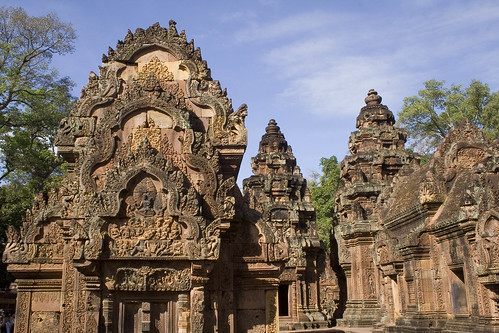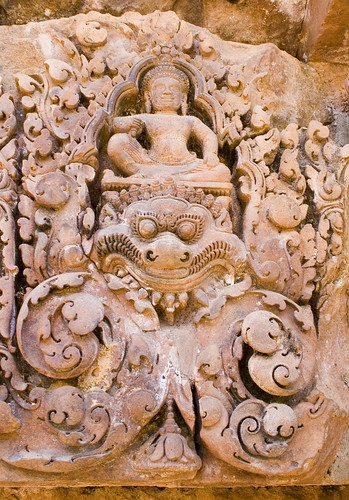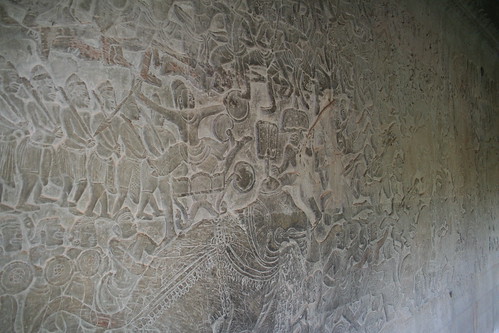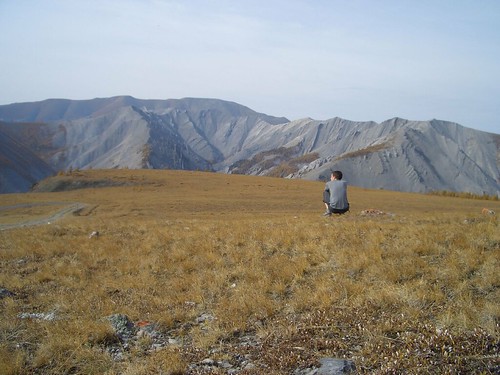
 My first impression of the site was another feeling of awe. The tops of the walls & doors were much more flamboyant; the stone top of the inner entrance whisked towards the sky like flames. The building was in pristine condition. When we were visiting, there was not any restoration happening, but the center of the temples had been roped off to restrict visitors from entering. I haven't done any research to determine if it had been restored at some point - it didn't look as though any stone had ever been moved after the temple was constructed. After seeing Banteay Srei, I added it to my list of top sites in Angkor Archaeological Park. For anyone going to visit, my top five favorites are:
My first impression of the site was another feeling of awe. The tops of the walls & doors were much more flamboyant; the stone top of the inner entrance whisked towards the sky like flames. The building was in pristine condition. When we were visiting, there was not any restoration happening, but the center of the temples had been roped off to restrict visitors from entering. I haven't done any research to determine if it had been restored at some point - it didn't look as though any stone had ever been moved after the temple was constructed. After seeing Banteay Srei, I added it to my list of top sites in Angkor Archaeological Park. For anyone going to visit, my top five favorites are:1. Angkor Wat
2. Angkor Thom
3. Banteay Srei
4. Ta Prohm
5. Bakong
After we were finished at Banteay Srei, James & I decided that we didn't want to spend the remainder of the day visiting mediocre temples. On our way back from Banteay Srei, I asked Buntay to stop at the Landmine Museum. http://www.cambodialandminemuseum.org/ The museum is not gigantic, but it houses information on landmines & their effects on Cambodia. In addition, empty munitions rounds are housed in the museum with information about what country they were produced in.
The guy that runs the museum, Aki Ra, has one hell of a life story. He was pulled into the Khmer Rouge during the rein of Pol Pot from 1975 - 1979. The Khmer Rouge period was one of Cambodia's darkest hours: a quote from Wikipedia.org provides a succinct summary:
The Khmer Rouge is remembered mainly for the deaths of an estimated 1.5 million people (estimates range from 850,000 to 3 million) under its regime, through execution, starvation, and forced labor. Following their leader Pol Pot, the Khmer Rouge imposed an extreme form of social engineering on Cambodian society—a radical form of agrarian communism where the whole population had to work in collective farms or forced labor projects.
Aki's job while in the Khmer Rouge was to plant landmines. After some period of time, he realized that he wanted to clean up a mistake that he participated in, so he began clearing landmines & started a museum to educate people. International funding also helps to run an orphanage for young kids who are victims of landmines. They teach the kids in a building adjacent to the museum and can often provide more than the children's families, in terms of both economic & physical aid. After a sobering tour through the museum, we climbed back in the tuk tuk and headed back to town. We ate lunch and then decided the rest of the day would best be spent visiting Siem Reap's museums. We had two to visit - the War Museum & Angkor National Museum.
The war museum was a collection of (mostly) US military equipment that had been left over from the Khmer Rouge period. They had a helicopter, airplane, several pieces of artillery, a tank, and plenty of guns, grenades, and landmines. The admission was $3, and a guide was included in the cost of the admission. The guy that was guiding us around was an old war veteran. Before we even started the tour, he made sure that we were aware of the suffering that he had endured in the past - two gunshots and several ball bearings as a result of a mine. While we were walking around, he was explaining what the items were and what they had been used for. Every 5 minutes, he would describe some more of his ailments, followed by "sorry friends, but these are my problems". After the 3rd time, I was starting to get really annoyed. I hadn't come to the museum to walk around with a beggar, as it was clear he was trying to get a donation. Sure enough, towards the end of the tour he pitched a wonderful story about losing some appendages if he couldn't have an operation in the next two weeks. When I looked at him, he was in decent health. There's no doubt that his war wounds probably caused him prolonged, acute pain each & everyday of his life. However, my heart wasn't bleeding that day so I passed up his offer to give him money.
We spent a few hours at the Angkor National Museum, which is absolutely worth the cost of $8. While we were exploring the ruins the previous days, there were always many statues, Buddha heads, and other large carvings removed from the ruins. In an effort to protect the ruins from looters, the government removed much of the work that could be carried off. I'm not sure how long it had been locked up for, but they finally completed the museum this fall. It's a very modern facility; so much so that it feels out of place in Siem Reap. After spending several days wandering around the ruins, the museum really helped to bind all of the things that we had seen. The different Khmer eras were laid out, followed by descriptions of the mixed Buddhist/Hindu religious pieces that make up every piece of the Angkor Archaeological Park. Not knowing much about Hinduism in the past, the gods were described and suddenly many of the bas-reliefs that we saw at Angkor Wat were explained.

On our way out of the museum, one of the women working in the museum gift shop asked where we were from. We proceeded to talk to her for at least 30 minutes about all sorts of things. She was saving money for university and was working two jobs - at the museum during the day and at a restaurant during the evenings. She worked six days per week at each job, allocated herself 4 hours of sleep per night, and spent about 16 hours working each day. After hearing about her strenuous schedule, I asked how much university cost per year. Her answer made my stomach drop - about $300US per year. This young woman was busting her ass for over a year so that she could get the money together to go to university. As I've seen in many other developing nations, she wanted to be a tour guide. It's a good paying job, and one of the jobs that is closest to the influx of tourist cash. I stopped by her restaurant that evening for dinner, as it was supposed to be one of the better restaurants in town. Regretfully, we didn't much time to talk and I never got her contact information. I've been thinking about it ever since, and I've pledged to myself that I will try to contact her again and provide some funding so that she can attend school.

No comments:
Post a Comment